The NVIDIA GeForce RTX 2080 Ti & RTX 2080 Founders Edition Review: Foundations For A Ray Traced Future
by Nate Oh on September 19, 2018 5:15 PM EST- Posted in
- GPUs
- Raytrace
- GeForce
- NVIDIA
- DirectX Raytracing
- Turing
- GeForce RTX
Power, Temperature, and Noise
With a large chip, more transistors, and more frames, questions always pivot to the efficiency of the card, and how well it sits with the overall power consumption, thermal limits of the default ‘coolers’, and the local noise of the fans when at load. Users buying these cards are going to be expected to push some pixels, which will have knock on effects inside a case. For our testing, we use a case for the best real-world results in these metrics.
Power
All of our graphics cards pivot around the 83-86W level when idle, though it is noticeable that they are in sets: the 2080 is below the 1080, the 2080 Ti sits above the 1080 Ti, and the Vega 64 consumes the most.
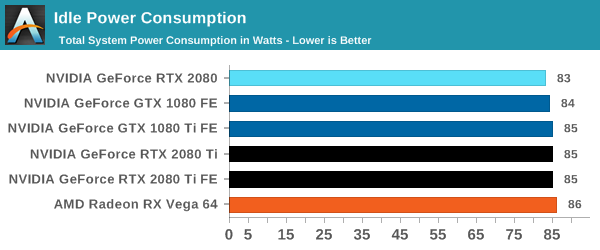
When we crank up a real-world title, all the RTX 20-series cards are pushing more power. The 2080 consumes 10W over the previous generation flagship, the 1080 Ti, and the new 2080 Ti flagship goes for another 50W system power beyond this. Still not as much as the Vega 64, however.
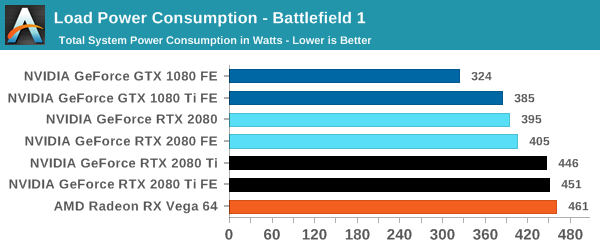
For a synthetic like Furmark, the RTX 2080 results show that it consumes less than the GTX 1080 Ti, although the GTX 1080 is some 50W less. The margin between the RTX 2080 FE and RTX 2080 Ti FE is some 40W, which is indicative of the official TDP differences. At the top end, the RTX 2080 Ti FE and RX Vega 64 are consuming equal power, however the RTX 2080 Ti FE is pushing through more work.
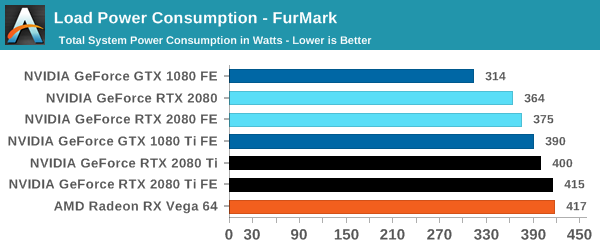
For power, the overall differences are quite clear: the RTX 2080 Ti is a step up above the RTX 2080, however the RTX 2080 shows that it is similar to the previous generation 1080/1080 Ti.
Temperature
Straight off the bat, moving from the blower cooler to the dual fan coolers, we see that the RTX 2080 holds its temperature a lot better than the previous generation GTX 1080 and GTX 1080 Ti.
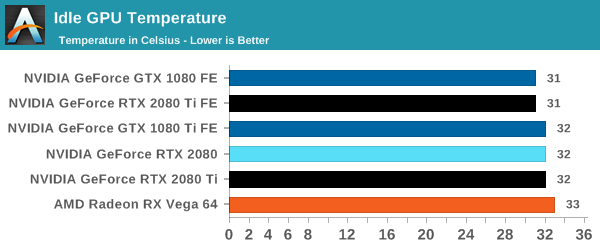
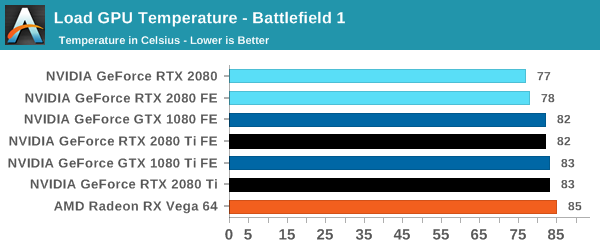
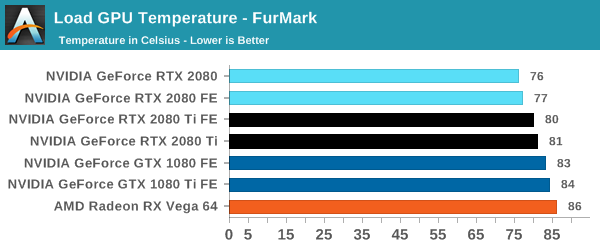
At each circumstance at load, the RTX 2080 is several degrees cooler than both the previous generation and the RTX 2080 Ti. The 2080 Ti fairs well in Furmark, coming in at a lower temperature than the 10-series, but trades blows in Battlefield. This is a win for the dual fan cooler, rather than the blower.
Noise
Similar to the temperature, the noise profile of the two larger fans rather than a single blower means that the new RTX cards can be quieter than the previous generation: the RTX 2080 wins here, showing that it can be 3-5 dB(A) lower than the 10-series and perform similar. The added power needed for the RTX 2080 Ti means that it is still competing against the GTX 1080, but it always beats the GTX 1080 Ti by comparison.
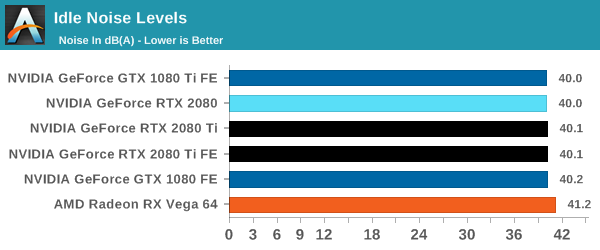
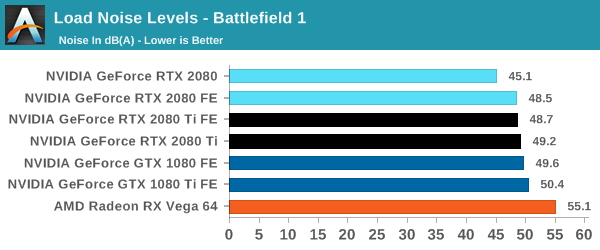
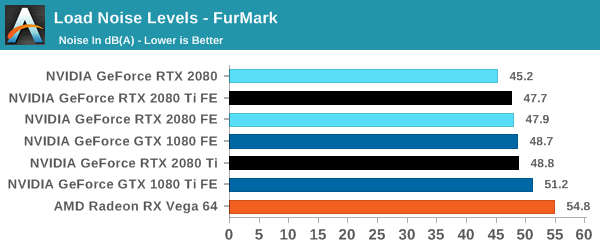










337 Comments
View All Comments
mapesdhs - Thursday, September 27, 2018 - link
Does the site earn anything from your reading their articles? Just curious.sing_electric - Thursday, September 20, 2018 - link
I really wonder how well raytracing will be implemented in the next 1-2 years. My bet is that for many of the titles Nvidia's announced, the effects will be limited and sort of gimicky, and the real benefits will come with titles that are starting development now (or, more likely, in a few months, when devs can look at how the 1st attempts at using RT faired).If my hunch is right, then that means that the RT features are likely to be of little practical use in this generation, since the real benefits won't come until some point after Nvidia's next-gen (7nm? 5?) chips come out with much-improved performance.
MadManMark - Thursday, September 20, 2018 - link
It sounds like the 2080 TI at maybe 1440 might be viable for RT. But yeah, for the most part this is about the future, and starting to get some games out there so for future releses there is not the "chicken & egg" problem they have now (no games to use it for, but reason there are no games is there are no cards to use it).Nvidia clearly sacrificing short-term profitability to establish this base; notice how the 2080 is both priced & performs about the same as the 1080 Ti. With the larger die size despite 12nmFF, driver development costs, etc, there is little doubt in my mind that Nvidia will be making a bigger margin on the 1080 Ti than the 2080. But they want to make it cheap enough so that, even if there is little to gain RIGHT NOW from buying 2080 instead fo 1080 Ti, there is also little lost either.
milkod2001 - Thursday, September 20, 2018 - link
It will have to be AMD who also jumps on raytracing thing first then maybe game developers will take it seriously.MadManMark - Thursday, September 20, 2018 - link
"Bartender, I'll have what milkod2001's having!" ;)El Sama - Thursday, September 20, 2018 - link
RTX 2080 not worth buying right now, 1080ti is cheaper (lol), cooler and performs equal. RTX 2080ti is a 1200+ Card that is around 60% price increase from 1080ti for a 25-28% performance increase? How is that a good purchase? Neither of them are worth buying right now.Toadster - Thursday, September 20, 2018 - link
decisions - 24 monthly payments for an iPhone XS Max? or GTX 2080Ti :)milkod2001 - Thursday, September 20, 2018 - link
Get iPhone if you want to be cool guy, you cannot put RTX 2080ti into your pocket :)Arbie - Thursday, September 20, 2018 - link
THANK YOU for the Ashes of the Singularity benchmark results. The deltas may not translate to other games but show me exactly what to expect from an upgrade.darckhart - Thursday, September 20, 2018 - link
But NVIDIA's key features - such as real time ray tracing and DLSS - aren't being utilized by any games right at launch. In fact, it's not very clear at all when those games might arrive, because NVIDIA ultimately is reliant on developers here.In the Star Wars Reflections demo, we measured the RTX 2080 Ti Founders Edition managing around a 14.7fps average at 4K and 31.4fps average at 1440p when rendering the real time ray traced scene. With DLSS enabled, it jumps to 33.8 and 57.2fps
Direct quotes from article. Price premium for NV tech that (1) will not be in games at launch and may have months of buggy implementation from early adoption and may not have widespread adoption, (2) needs extreme help from DLSS to have usable framerates. Should've been named DTX not RTX.